University: International Financial Management Homework 2 - FIN3IFM
VerifiedAdded on 2022/11/13
|9
|1473
|157
Homework Assignment
AI Summary
This homework assignment on International Financial Management (FIN3IFM) addresses key concepts in international finance. It begins by defining and differentiating between transaction, economic, and translation exposures, providing examples of each. The assignment then explores the role of hedging in mitigating these exposures, particularly in imperfect capital markets. It delves into the causes and implications of the global financial crisis, focusing on liquidity risks, off-balance sheet market risks, and the actions of financial intermediaries. Furthermore, it examines the role of structured investment vehicles (SIVs) and collateralized debt obligations (CDOs) in the crisis. The assignment provides a comprehensive overview of the core issues in international finance, providing a solid foundation for understanding financial risk and management in a global context.
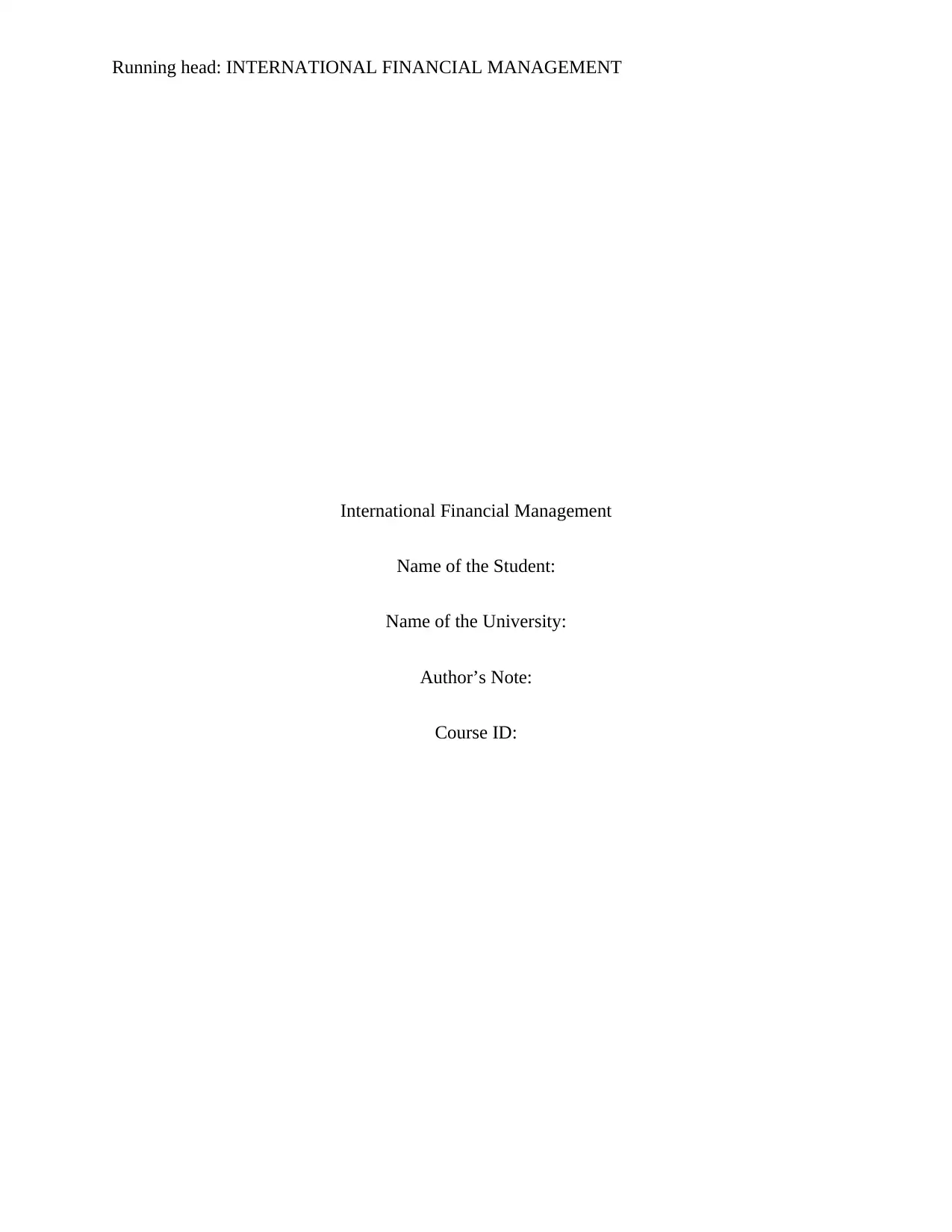
Running head: INTERNATIONAL FINANCIAL MANAGEMENT
International Financial Management
Name of the Student:
Name of the University:
Author’s Note:
Course ID:
International Financial Management
Name of the Student:
Name of the University:
Author’s Note:
Course ID:
Paraphrase This Document
Need a fresh take? Get an instant paraphrase of this document with our AI Paraphraser
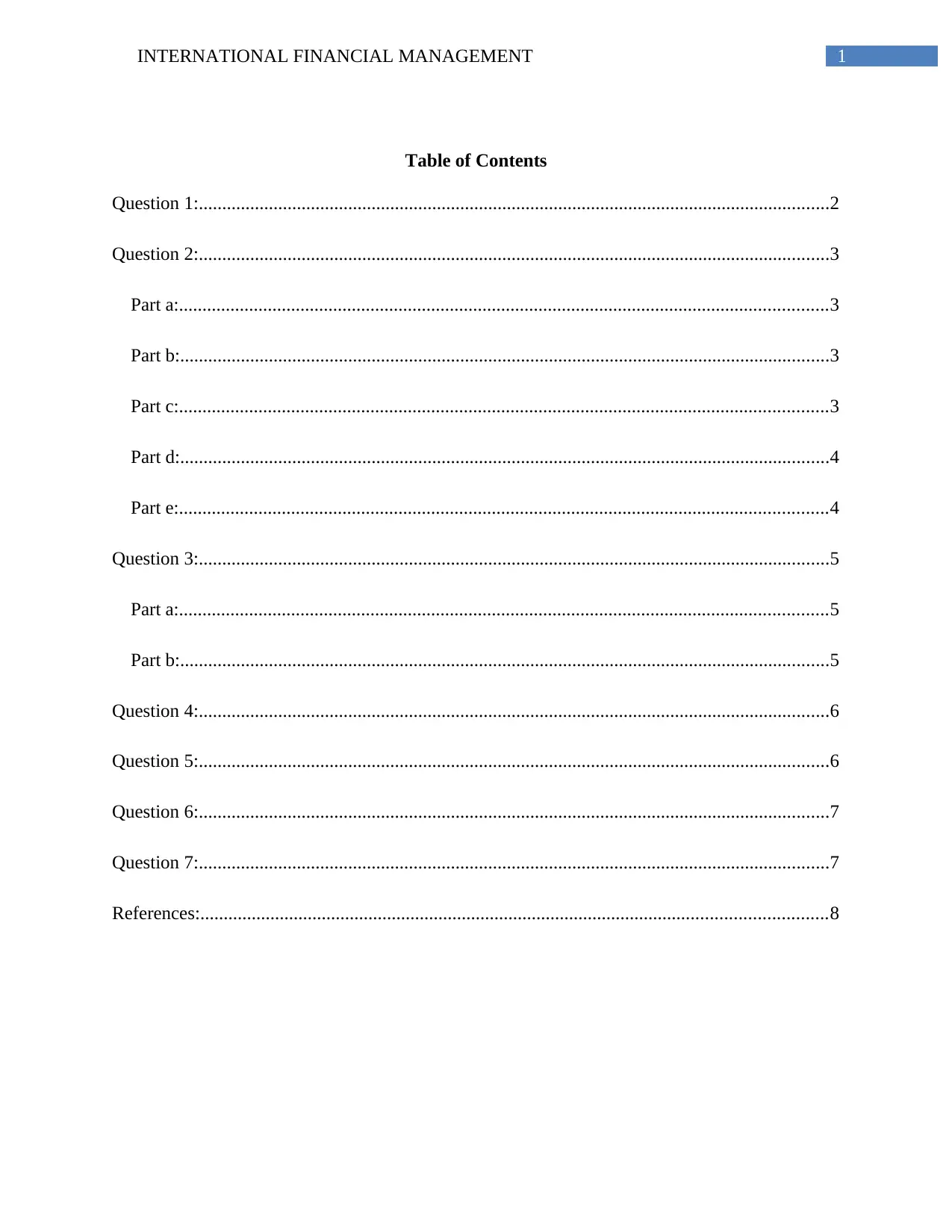
1INTERNATIONAL FINANCIAL MANAGEMENT
Table of Contents
Question 1:.......................................................................................................................................2
Question 2:.......................................................................................................................................3
Part a:...........................................................................................................................................3
Part b:...........................................................................................................................................3
Part c:...........................................................................................................................................3
Part d:...........................................................................................................................................4
Part e:...........................................................................................................................................4
Question 3:.......................................................................................................................................5
Part a:...........................................................................................................................................5
Part b:...........................................................................................................................................5
Question 4:.......................................................................................................................................6
Question 5:.......................................................................................................................................6
Question 6:.......................................................................................................................................7
Question 7:.......................................................................................................................................7
References:......................................................................................................................................8
Table of Contents
Question 1:.......................................................................................................................................2
Question 2:.......................................................................................................................................3
Part a:...........................................................................................................................................3
Part b:...........................................................................................................................................3
Part c:...........................................................................................................................................3
Part d:...........................................................................................................................................4
Part e:...........................................................................................................................................4
Question 3:.......................................................................................................................................5
Part a:...........................................................................................................................................5
Part b:...........................................................................................................................................5
Question 4:.......................................................................................................................................6
Question 5:.......................................................................................................................................6
Question 6:.......................................................................................................................................7
Question 7:.......................................................................................................................................7
References:......................................................................................................................................8
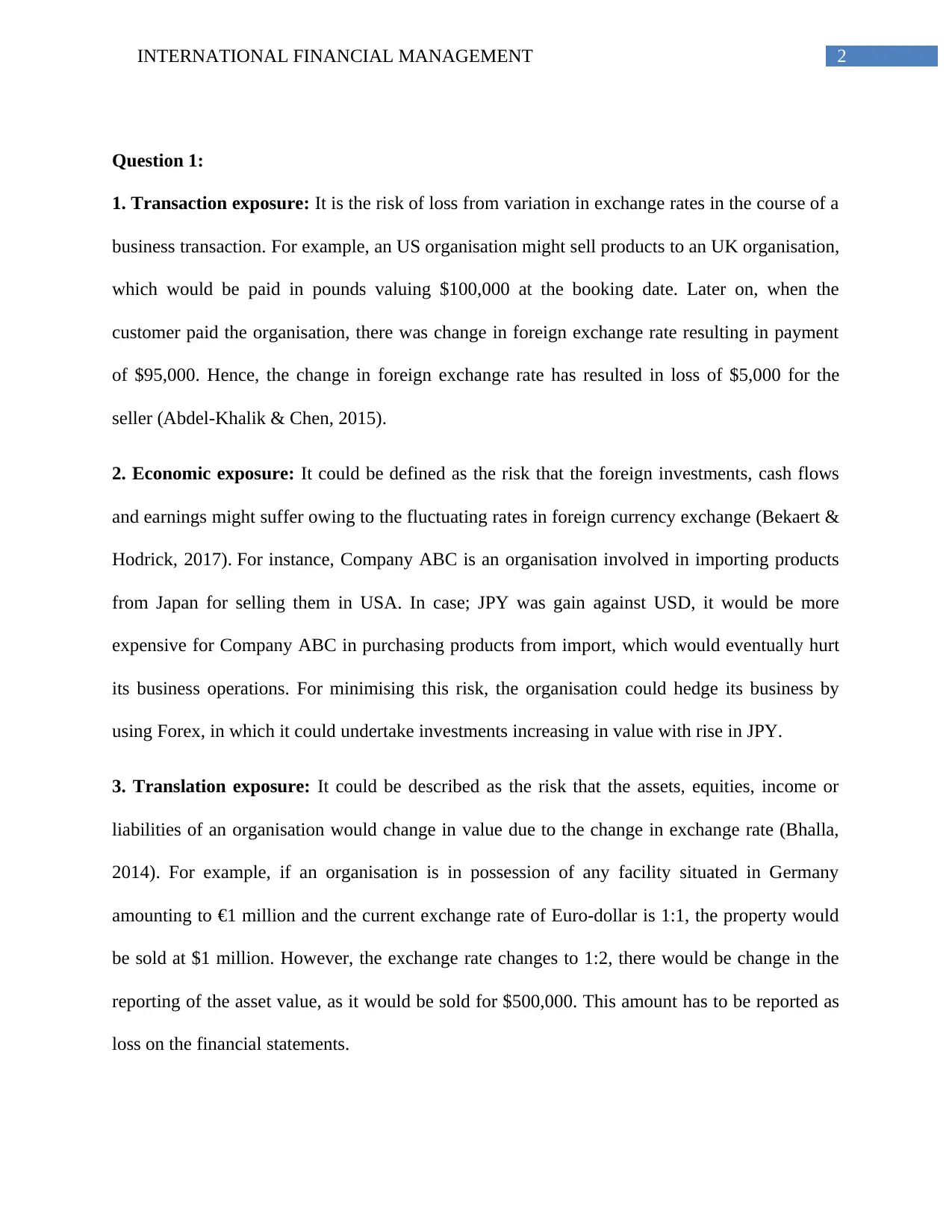
2INTERNATIONAL FINANCIAL MANAGEMENT
Question 1:
1. Transaction exposure: It is the risk of loss from variation in exchange rates in the course of a
business transaction. For example, an US organisation might sell products to an UK organisation,
which would be paid in pounds valuing $100,000 at the booking date. Later on, when the
customer paid the organisation, there was change in foreign exchange rate resulting in payment
of $95,000. Hence, the change in foreign exchange rate has resulted in loss of $5,000 for the
seller (Abdel-Khalik & Chen, 2015).
2. Economic exposure: It could be defined as the risk that the foreign investments, cash flows
and earnings might suffer owing to the fluctuating rates in foreign currency exchange (Bekaert &
Hodrick, 2017). For instance, Company ABC is an organisation involved in importing products
from Japan for selling them in USA. In case; JPY was gain against USD, it would be more
expensive for Company ABC in purchasing products from import, which would eventually hurt
its business operations. For minimising this risk, the organisation could hedge its business by
using Forex, in which it could undertake investments increasing in value with rise in JPY.
3. Translation exposure: It could be described as the risk that the assets, equities, income or
liabilities of an organisation would change in value due to the change in exchange rate (Bhalla,
2014). For example, if an organisation is in possession of any facility situated in Germany
amounting to €1 million and the current exchange rate of Euro-dollar is 1:1, the property would
be sold at $1 million. However, the exchange rate changes to 1:2, there would be change in the
reporting of the asset value, as it would be sold for $500,000. This amount has to be reported as
loss on the financial statements.
Question 1:
1. Transaction exposure: It is the risk of loss from variation in exchange rates in the course of a
business transaction. For example, an US organisation might sell products to an UK organisation,
which would be paid in pounds valuing $100,000 at the booking date. Later on, when the
customer paid the organisation, there was change in foreign exchange rate resulting in payment
of $95,000. Hence, the change in foreign exchange rate has resulted in loss of $5,000 for the
seller (Abdel-Khalik & Chen, 2015).
2. Economic exposure: It could be defined as the risk that the foreign investments, cash flows
and earnings might suffer owing to the fluctuating rates in foreign currency exchange (Bekaert &
Hodrick, 2017). For instance, Company ABC is an organisation involved in importing products
from Japan for selling them in USA. In case; JPY was gain against USD, it would be more
expensive for Company ABC in purchasing products from import, which would eventually hurt
its business operations. For minimising this risk, the organisation could hedge its business by
using Forex, in which it could undertake investments increasing in value with rise in JPY.
3. Translation exposure: It could be described as the risk that the assets, equities, income or
liabilities of an organisation would change in value due to the change in exchange rate (Bhalla,
2014). For example, if an organisation is in possession of any facility situated in Germany
amounting to €1 million and the current exchange rate of Euro-dollar is 1:1, the property would
be sold at $1 million. However, the exchange rate changes to 1:2, there would be change in the
reporting of the asset value, as it would be sold for $500,000. This amount has to be reported as
loss on the financial statements.
⊘ This is a preview!⊘
Do you want full access?
Subscribe today to unlock all pages.

Trusted by 1+ million students worldwide
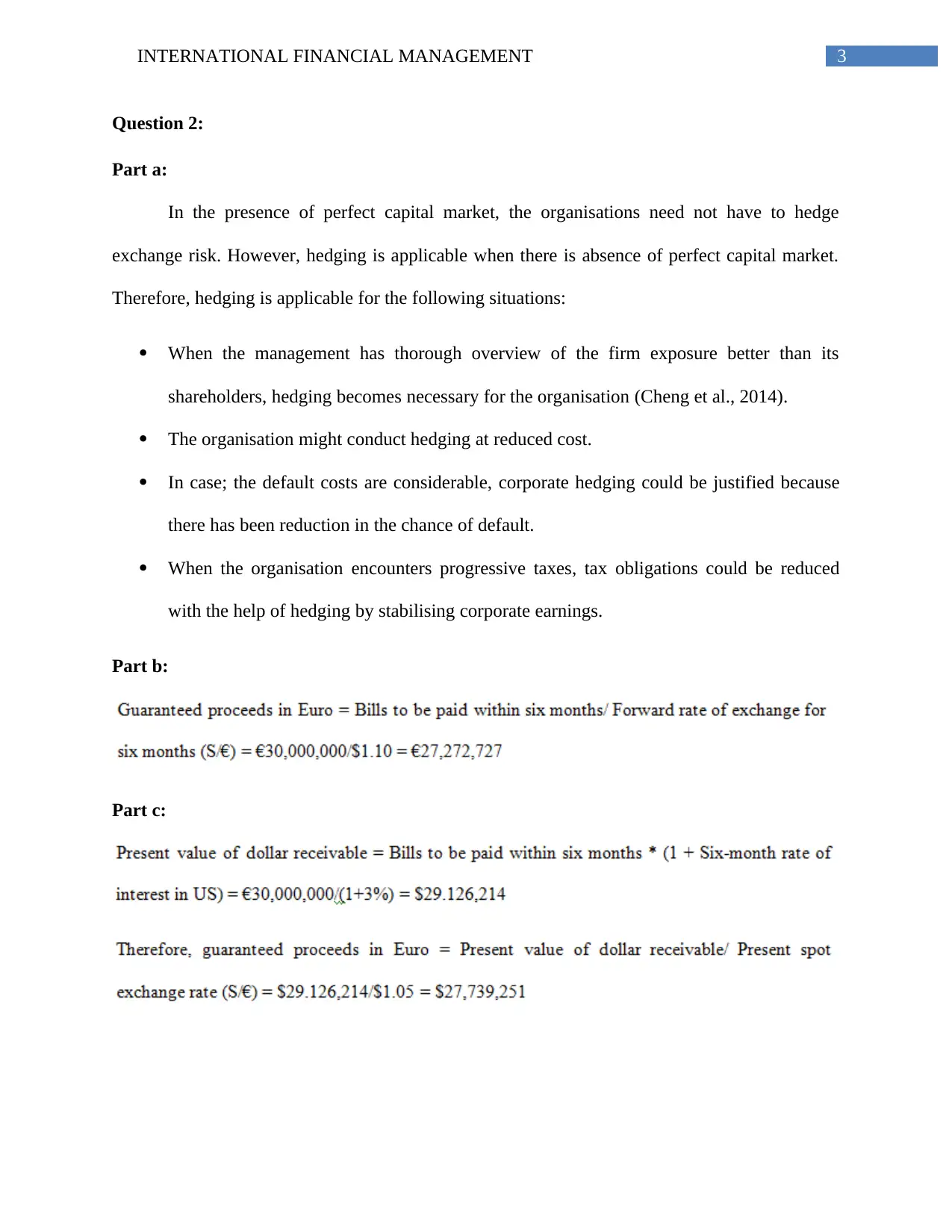
3INTERNATIONAL FINANCIAL MANAGEMENT
Question 2:
Part a:
In the presence of perfect capital market, the organisations need not have to hedge
exchange risk. However, hedging is applicable when there is absence of perfect capital market.
Therefore, hedging is applicable for the following situations:
When the management has thorough overview of the firm exposure better than its
shareholders, hedging becomes necessary for the organisation (Cheng et al., 2014).
The organisation might conduct hedging at reduced cost.
In case; the default costs are considerable, corporate hedging could be justified because
there has been reduction in the chance of default.
When the organisation encounters progressive taxes, tax obligations could be reduced
with the help of hedging by stabilising corporate earnings.
Part b:
Part c:
Question 2:
Part a:
In the presence of perfect capital market, the organisations need not have to hedge
exchange risk. However, hedging is applicable when there is absence of perfect capital market.
Therefore, hedging is applicable for the following situations:
When the management has thorough overview of the firm exposure better than its
shareholders, hedging becomes necessary for the organisation (Cheng et al., 2014).
The organisation might conduct hedging at reduced cost.
In case; the default costs are considerable, corporate hedging could be justified because
there has been reduction in the chance of default.
When the organisation encounters progressive taxes, tax obligations could be reduced
with the help of hedging by stabilising corporate earnings.
Part b:
Part c:
Paraphrase This Document
Need a fresh take? Get an instant paraphrase of this document with our AI Paraphraser
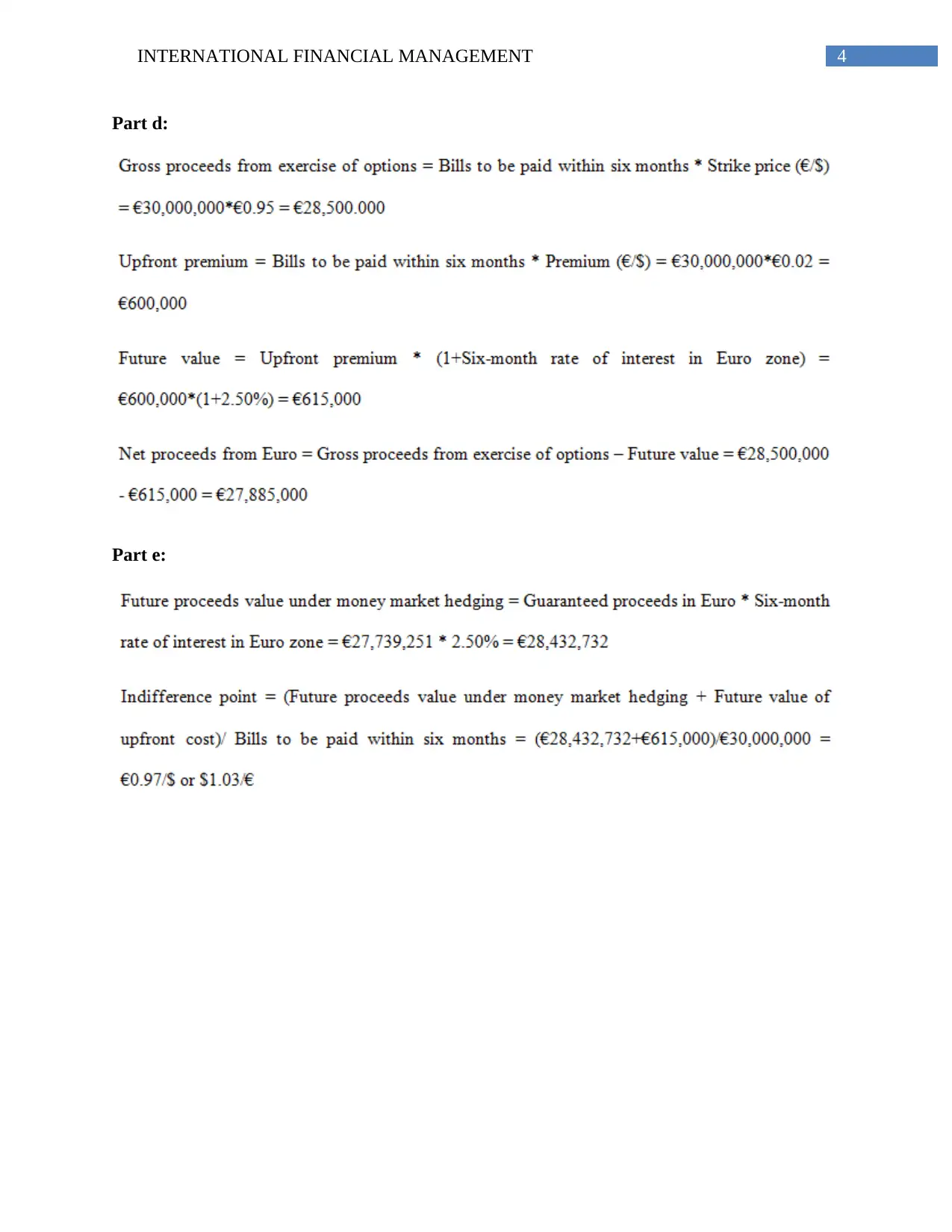
4INTERNATIONAL FINANCIAL MANAGEMENT
Part d:
Part e:
Part d:
Part e:
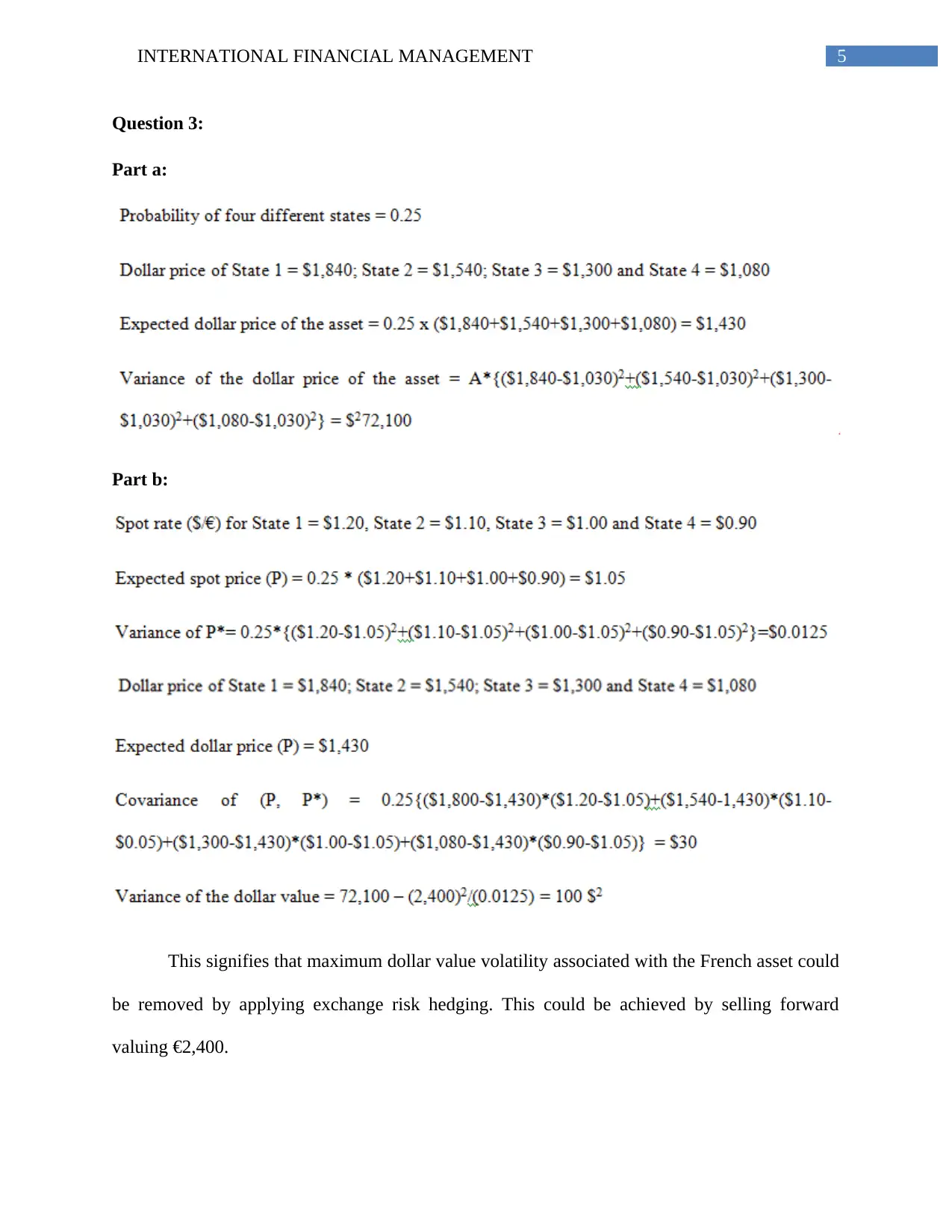
5INTERNATIONAL FINANCIAL MANAGEMENT
Question 3:
Part a:
Part b:
This signifies that maximum dollar value volatility associated with the French asset could
be removed by applying exchange risk hedging. This could be achieved by selling forward
valuing €2,400.
Question 3:
Part a:
Part b:
This signifies that maximum dollar value volatility associated with the French asset could
be removed by applying exchange risk hedging. This could be achieved by selling forward
valuing €2,400.
⊘ This is a preview!⊘
Do you want full access?
Subscribe today to unlock all pages.

Trusted by 1+ million students worldwide
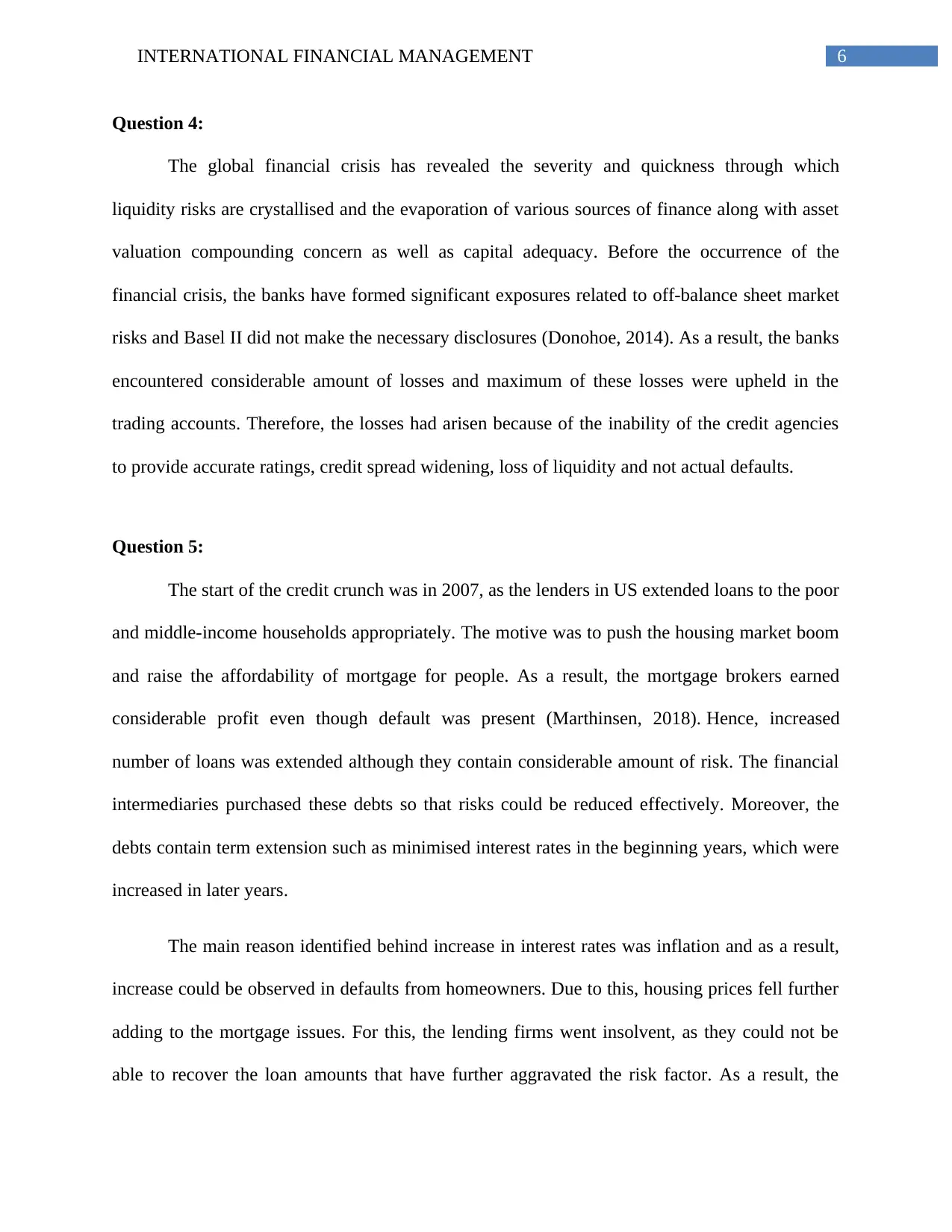
6INTERNATIONAL FINANCIAL MANAGEMENT
Question 4:
The global financial crisis has revealed the severity and quickness through which
liquidity risks are crystallised and the evaporation of various sources of finance along with asset
valuation compounding concern as well as capital adequacy. Before the occurrence of the
financial crisis, the banks have formed significant exposures related to off-balance sheet market
risks and Basel II did not make the necessary disclosures (Donohoe, 2014). As a result, the banks
encountered considerable amount of losses and maximum of these losses were upheld in the
trading accounts. Therefore, the losses had arisen because of the inability of the credit agencies
to provide accurate ratings, credit spread widening, loss of liquidity and not actual defaults.
Question 5:
The start of the credit crunch was in 2007, as the lenders in US extended loans to the poor
and middle-income households appropriately. The motive was to push the housing market boom
and raise the affordability of mortgage for people. As a result, the mortgage brokers earned
considerable profit even though default was present (Marthinsen, 2018). Hence, increased
number of loans was extended although they contain considerable amount of risk. The financial
intermediaries purchased these debts so that risks could be reduced effectively. Moreover, the
debts contain term extension such as minimised interest rates in the beginning years, which were
increased in later years.
The main reason identified behind increase in interest rates was inflation and as a result,
increase could be observed in defaults from homeowners. Due to this, housing prices fell further
adding to the mortgage issues. For this, the lending firms went insolvent, as they could not be
able to recover the loan amounts that have further aggravated the risk factor. As a result, the
Question 4:
The global financial crisis has revealed the severity and quickness through which
liquidity risks are crystallised and the evaporation of various sources of finance along with asset
valuation compounding concern as well as capital adequacy. Before the occurrence of the
financial crisis, the banks have formed significant exposures related to off-balance sheet market
risks and Basel II did not make the necessary disclosures (Donohoe, 2014). As a result, the banks
encountered considerable amount of losses and maximum of these losses were upheld in the
trading accounts. Therefore, the losses had arisen because of the inability of the credit agencies
to provide accurate ratings, credit spread widening, loss of liquidity and not actual defaults.
Question 5:
The start of the credit crunch was in 2007, as the lenders in US extended loans to the poor
and middle-income households appropriately. The motive was to push the housing market boom
and raise the affordability of mortgage for people. As a result, the mortgage brokers earned
considerable profit even though default was present (Marthinsen, 2018). Hence, increased
number of loans was extended although they contain considerable amount of risk. The financial
intermediaries purchased these debts so that risks could be reduced effectively. Moreover, the
debts contain term extension such as minimised interest rates in the beginning years, which were
increased in later years.
The main reason identified behind increase in interest rates was inflation and as a result,
increase could be observed in defaults from homeowners. Due to this, housing prices fell further
adding to the mortgage issues. For this, the lending firms went insolvent, as they could not be
able to recover the loan amounts that have further aggravated the risk factor. As a result, the
Paraphrase This Document
Need a fresh take? Get an instant paraphrase of this document with our AI Paraphraser
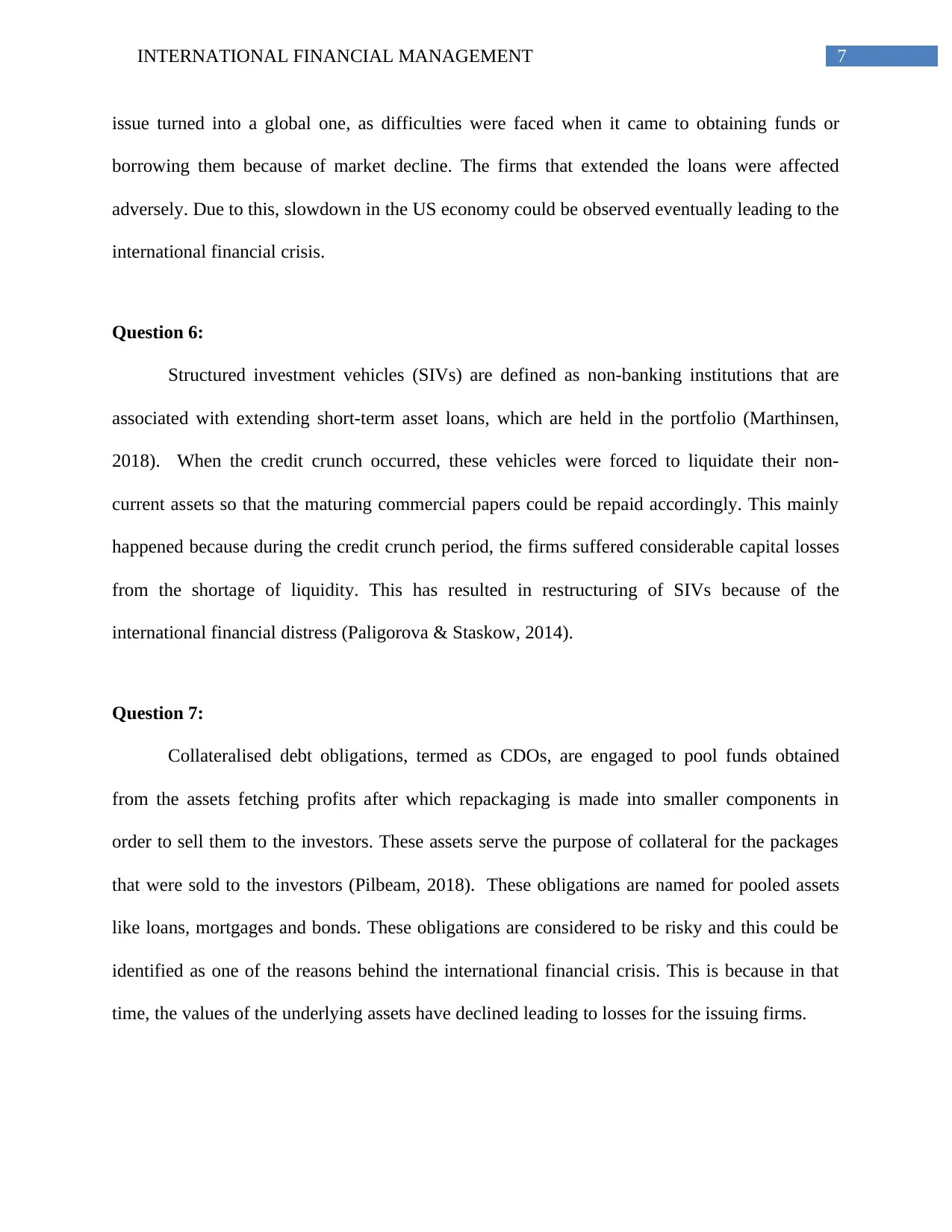
7INTERNATIONAL FINANCIAL MANAGEMENT
issue turned into a global one, as difficulties were faced when it came to obtaining funds or
borrowing them because of market decline. The firms that extended the loans were affected
adversely. Due to this, slowdown in the US economy could be observed eventually leading to the
international financial crisis.
Question 6:
Structured investment vehicles (SIVs) are defined as non-banking institutions that are
associated with extending short-term asset loans, which are held in the portfolio (Marthinsen,
2018). When the credit crunch occurred, these vehicles were forced to liquidate their non-
current assets so that the maturing commercial papers could be repaid accordingly. This mainly
happened because during the credit crunch period, the firms suffered considerable capital losses
from the shortage of liquidity. This has resulted in restructuring of SIVs because of the
international financial distress (Paligorova & Staskow, 2014).
Question 7:
Collateralised debt obligations, termed as CDOs, are engaged to pool funds obtained
from the assets fetching profits after which repackaging is made into smaller components in
order to sell them to the investors. These assets serve the purpose of collateral for the packages
that were sold to the investors (Pilbeam, 2018). These obligations are named for pooled assets
like loans, mortgages and bonds. These obligations are considered to be risky and this could be
identified as one of the reasons behind the international financial crisis. This is because in that
time, the values of the underlying assets have declined leading to losses for the issuing firms.
issue turned into a global one, as difficulties were faced when it came to obtaining funds or
borrowing them because of market decline. The firms that extended the loans were affected
adversely. Due to this, slowdown in the US economy could be observed eventually leading to the
international financial crisis.
Question 6:
Structured investment vehicles (SIVs) are defined as non-banking institutions that are
associated with extending short-term asset loans, which are held in the portfolio (Marthinsen,
2018). When the credit crunch occurred, these vehicles were forced to liquidate their non-
current assets so that the maturing commercial papers could be repaid accordingly. This mainly
happened because during the credit crunch period, the firms suffered considerable capital losses
from the shortage of liquidity. This has resulted in restructuring of SIVs because of the
international financial distress (Paligorova & Staskow, 2014).
Question 7:
Collateralised debt obligations, termed as CDOs, are engaged to pool funds obtained
from the assets fetching profits after which repackaging is made into smaller components in
order to sell them to the investors. These assets serve the purpose of collateral for the packages
that were sold to the investors (Pilbeam, 2018). These obligations are named for pooled assets
like loans, mortgages and bonds. These obligations are considered to be risky and this could be
identified as one of the reasons behind the international financial crisis. This is because in that
time, the values of the underlying assets have declined leading to losses for the issuing firms.
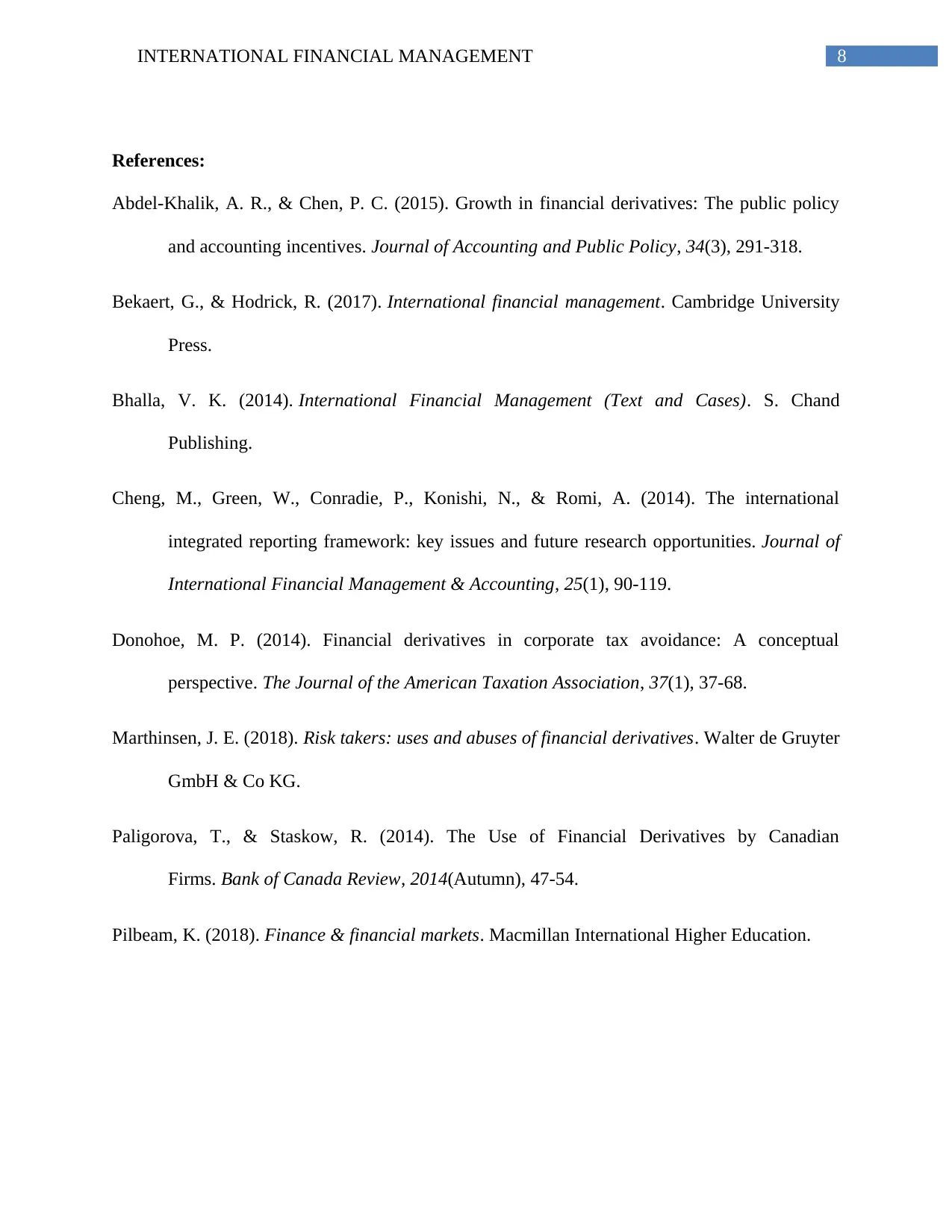
8INTERNATIONAL FINANCIAL MANAGEMENT
References:
Abdel-Khalik, A. R., & Chen, P. C. (2015). Growth in financial derivatives: The public policy
and accounting incentives. Journal of Accounting and Public Policy, 34(3), 291-318.
Bekaert, G., & Hodrick, R. (2017). International financial management. Cambridge University
Press.
Bhalla, V. K. (2014). International Financial Management (Text and Cases). S. Chand
Publishing.
Cheng, M., Green, W., Conradie, P., Konishi, N., & Romi, A. (2014). The international
integrated reporting framework: key issues and future research opportunities. Journal of
International Financial Management & Accounting, 25(1), 90-119.
Donohoe, M. P. (2014). Financial derivatives in corporate tax avoidance: A conceptual
perspective. The Journal of the American Taxation Association, 37(1), 37-68.
Marthinsen, J. E. (2018). Risk takers: uses and abuses of financial derivatives. Walter de Gruyter
GmbH & Co KG.
Paligorova, T., & Staskow, R. (2014). The Use of Financial Derivatives by Canadian
Firms. Bank of Canada Review, 2014(Autumn), 47-54.
Pilbeam, K. (2018). Finance & financial markets. Macmillan International Higher Education.
References:
Abdel-Khalik, A. R., & Chen, P. C. (2015). Growth in financial derivatives: The public policy
and accounting incentives. Journal of Accounting and Public Policy, 34(3), 291-318.
Bekaert, G., & Hodrick, R. (2017). International financial management. Cambridge University
Press.
Bhalla, V. K. (2014). International Financial Management (Text and Cases). S. Chand
Publishing.
Cheng, M., Green, W., Conradie, P., Konishi, N., & Romi, A. (2014). The international
integrated reporting framework: key issues and future research opportunities. Journal of
International Financial Management & Accounting, 25(1), 90-119.
Donohoe, M. P. (2014). Financial derivatives in corporate tax avoidance: A conceptual
perspective. The Journal of the American Taxation Association, 37(1), 37-68.
Marthinsen, J. E. (2018). Risk takers: uses and abuses of financial derivatives. Walter de Gruyter
GmbH & Co KG.
Paligorova, T., & Staskow, R. (2014). The Use of Financial Derivatives by Canadian
Firms. Bank of Canada Review, 2014(Autumn), 47-54.
Pilbeam, K. (2018). Finance & financial markets. Macmillan International Higher Education.
⊘ This is a preview!⊘
Do you want full access?
Subscribe today to unlock all pages.

Trusted by 1+ million students worldwide
1 out of 9
Related Documents
Your All-in-One AI-Powered Toolkit for Academic Success.
+13062052269
info@desklib.com
Available 24*7 on WhatsApp / Email
![[object Object]](/_next/static/media/star-bottom.7253800d.svg)
Unlock your academic potential
Copyright © 2020–2025 A2Z Services. All Rights Reserved. Developed and managed by ZUCOL.





